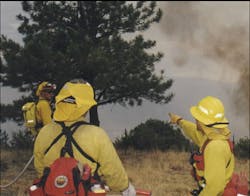In a previous article entitled "Communicating in the Wildland Interface," Rick Lynsky and I identified communication problems and solutions targeted at the equipment or the ways we use the equipment. Unfortunately equipment problems are probably only related to less than half of our overarching fireline communication shortcomings.
Situational awareness (SA) requires all individuals to pay closer attention to everything on the fireline, which is no easy chore. Therefore improved communications leads to a higher level of SA. All firefighters have an obligation to themselves and others to provide the best exchange of information possible. Improving our speaking and listening skills takes us one step closer to enhancing fireline communications.
Speaking & Listening Skills Required
Speaking skills consist of using common terminology, spoken with the appropriate volume, word enunciation, and with a moderate pace. Direct eye contact and a respectful tone of voice will also help to keep the listeners focused on the conversation, even when "cut to the chase," firm language is used. Casual conversation may be appropriate in all but the most intense situations, at which point firm statements will need to be employed. The goal is to get the information across without creating an atmosphere where the listener feels they cannot ask a question or make a comment. Try to remove as many distractions as possible such as moving away from engine noises and turning the radio speaker away from the group.
Listening skills should be used constantly. If you normally are a speaker, this can be challenging. Actively listening helps to update your situational awareness of the fireground itself and the personnel you are interacting with. Focus your attention on the speaker and watch for the nonverbal indicators which could point to an underlying issue. If the speaker is obviously stressed, for instance, inquire in a helpful way so the issue can be discussed. Low situational awareness could be the root of the problem; open discussions help to increase SA.
Basic guidelines of a good listener:
- Remove distractions.
- Stop talking and focus on the speaker.
- Make sure that you are listening, not just waiting to talk.
- You may already have a perception of the conversation. Try to keep it neutral.
- Don't interrupt; let the speaker finish their thoughts.
- If information is unclear, ask for it to be rephrased.
- Be a team player. What can you do to help the speaker be successful?
- Don't walk away until the conversation is finished.
When messages are passed from one individual to another, it is important to acknowledge that the information was received. Safe and effective fireline communications is a two-way process. Formal acknowledgments should be required for every message. While this may seem excessive, use of acknowledgments is vital when communicating critical messages. By doing this all the time, even during routine communications, it will become second nature. When speaking to more than one person, be sure to request a confirmation that the message was received by all parties. If this is over the radio, take the extra air time to verify.
Receivers have the responsibility to acknowledge messages and to request clarification if they did not completely understand. Saying "copy" or "got it" is not sufficient when acknowledging critical messages. Take the time to repeat it back to the speaker. This may seem like a lengthy process when time is short, but that is when all messages must be fully understood. Furthermore, if this process begins to degrade and co-workers regularly start to "drop" acknowledging the messages, factors such as stress and fatigue may soon become issues.
Communicating Under Pressure
Even with the best speaking and listening skills, we may still have trouble communicating, especially when the subject gets emotionally charged. According to Lark McDonald, CEO of Mission Centered Solutions, who has co-developed numerous nationally recognized fire leadership courses with a heavy emphasis on human factors, emotionally-charged subjects can activate defense mechanisms that try to keep us from looking foolish, but inhibit clear communication, thus affecting situational awareness.
When we communicate under these situations we tend to:
- Resist changing our initial perception when confronted with new information.
- Support our opinion even when we know it may not be totally correct.
- Shift blame when our message is misunderstood.
These are natural human tendencies which everyone exhibits from time to time. The key is to recognize that these "barriers" will affect the communication process. The true professional, whether paid or volunteer, will strive to keep these barriers from creating obstacles and devote full attention to the job at hand.
Loss of situational awareness is a contributing factor in most fire fatality and injury reports. The underlying benefit of conducting a briefing is that of increasing our situational awareness. Whenever implemented, all types of incidents benefit from these briefings. The perceived drawback is that they take too much time. A 60-second, or less, briefing can make a world of difference and is especially powerful when a known format is used every time so that the important information is always addressed.
An Effective Briefing
A properly conducted briefing is designed to inform all personnel of what is going on and why. Fully informed personnel will be better able to make sense out of the known versus unknown, which reduces stress, increases situational awareness, allows for better decision making, and ultimately leads to the proper amount of risk being taken.
Assertiveness is an important aspect of crew communications. In aviation research, the need for assertive behavior in more junior members has been found. Furthermore, voice recordings from the so-called "black boxes" have revealed the lack of assertiveness to be a contributing factor in more than one airline crash. More recent studies in other high-stake professions found that status differences in groups affects communication behaviors, such as speaking up or challenging a superior's position. This same effect can be seen within the fire service.
Assertiveness lies between a passive and aggressive emphasis in communications, which can be viewed as standing up for one's self in such a way as not to disregard the other person's opinion. This should yield a more open line of communication, but it takes practice and confidence if this is undertaken by a subordinate. Assertiveness may take some investigating to break through any decision making barriers that the speaker may be influenced by. In the end assertiveness may require persistence and objectivity to stay focused on the assignment while advocating your position. Remember, having a different opinion is not about who is right and who is wrong; it is about how best to undertake the assignment.
Another thought worth mentioning before starting a briefing is just how much information can a person actually remember? Research has shown that the average person can really only remember five to nine things at any given time. Throw in some stress and that number gets alarmingly low. When briefing, keep in mind that the individual may use different techniques to remember, so if someone asks you to repeat or rephrase, take the time to do it. This is a fine example of why two-way communication is so important: by repeating back the information, you are helping to keep it in memory...for a short time anyway.
A 60-second briefing cannot possibly cover everything. The key is to use a format that becomes ingrained. Remember all consecutive briefings will cover the hazards that are still present and focus on what's new. This is a skill that must be mastered by all firefighters regardless of rank, which ultimately leads to added crew cohesion.
A five-step briefing format should be used. Remember it is just the critical information you are conveying. If practiced and used on incidents and trainings, officers and firefighters should be able to touch on the five topic areas in as little as 30 seconds. Take more time to facilitate a more thorough briefing when necessary.
Five-Step Briefing Format
- 1. Current situation (this updates everyone's situational awareness)
- Critical life safety information; ex: fire is making a run, LCES is compromised.
- The overall strategy and tactics are made known.
- Other; supervisor, trigger points / disengagement procedures.
- Note: All crew members must communicate hazards they observe.
- The assignment
- The assignment is described along with the intent (task, purpose, end-state).
- Specific task or tasks to complete the assignment are discussed.
- Hazards associated with the assignment are identified.
- Contingency plans.
- How to make the assignment safe
- Recognition of the hazards by all crewmembers.
- Risk management; Should we be here? Can it be made safe?
- Ways to mitigate the hazards. i.e. LCES, Downhill line guidelines.
- Medevac plan.
- How to support the assignment
- Safety support.
- Logistical support.
- Tools you need to accomplish the tactic/task.
- Questions/concerns?
- Question: Does everyone know what we're doing and why?
- Concerns: What are we overlooking?
Note: This list is not all-inclusive. You can download it below.
Preparation And Planning
Briefings take practice. It is not feasible for most people to read this article and then conduct the perfect 60-second briefing. Remember to brush up on your speaking and active listening skills beforehand. Incorporate the briefing into incidents, trainings, and station life. Ask for feedback of your briefings and coach others on theirs.
Another good habit to get into is to write it down. For the 60-second version that may consist of just "buzz" words (a sticky note pad can be used; keep them everywhere). For longer briefings a written format is likely essential for keeping your train of thought going. Longer briefings almost always have distractions and interruptions.
Debriefing your actions immediately after completing a crew assignment is a good way of "spot checking" how the flow of information is being assimilated. This can literally be done in 30 seconds, and it ensures everyone still understands why they are doing what they are doing. If requested actions still don't make sense, situational awareness is low and a more defined intent will need to be verbalized from above.
In Conclusion
In conclusion, speaking and listening skills are used every day: work to increase their effectiveness. Acknowledge all messages and require the same of others. Be aware that you and those you converse with may build up barriers to solid communications. You must work to keep these obstacles to a minimum. Strive to improve your situational awareness and look for every opportunity to increase it, the five-step briefing format will assist you with that. Everyone possesses the ability to initiate and maintain excellent communications which ultimately helps to identify and mitigate life-threatening situations.
QUINN MacLEOD, owner and lead instructor of Integrated Fire Solutions, has been in the fire service since 1985 which includes 20 years on the line with the Parker, CO, Fire District. He is NWCG qualified as a wildfire Division Supervisor and holds an Associates Degree in Fire Science along with numerous state and national certifications, including Fire Officer and Fire Instructor. Quinn has delivered and received hundreds of briefings lasting from 30 seconds to 30 minutes. You can contact Quinn by e-mail at: [email protected].

